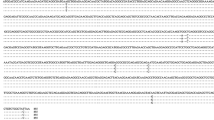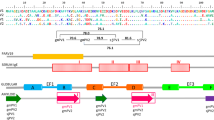Abstract
Tropomyosin (TM), the major shrimp allergen that belongs to a highly conserved protein family, has frequently been investigated owing to its high rate of human consumption. In this study, the sequence microheterogeneity of TMs, irrespective of the organism and differences in the N- and C-termini, from different shrimp species was analyzed. The TM sequences were analyzed using bioinformatics tools and confirmed by dot-blot using human serum. The results showed that all 13 shrimp species share high mutual TM sequence identity values, ranging from 85.5 to 99.7 %, and 60 cases of sequence microheterogeneity were identified in shrimp TM, with a sequence identity ranging from 90.1 to 99.7 %. A total of 719 unique amino acid residue substitutions (that affect 43 residues, 15 % of 284 residues) involving sequence microheterogeneity were characterized, in which 214 substitutions involving 15 residues were located in the epitope regions. About 45 % of these substitutions occurred in the TM sequences that are reported allergens, whereas 43 % of the substitutions occurred overall for the allergenic and nonallergenic TMs. Dot-blot immunoassay revealed that single microheterogeneous mutation of allergic peptides resulted in significant changes in the IgE-binding capacity of the peptides. Overall, microheterogeneous mutations of TM occurred in different shrimp species. These mutations can potentially induce changes in the IgE-binding capacity and might be responsible for variations in the hypersensitivity to different shrimp species.



Similar content being viewed by others
References
Monaci L, Tregoat V, van Hengel AJ, Anklam E (2006) Milk allergens, their characteristics and their detection in food: a review. J Eur Food Res Technol 223:149–179
Daul CB, Slattery M, Reese G, Lehrer SB (1994) Identification of the major brown shrimp (Penaeus aztecus) allergen as the muscle protein tropomyosin. J Int Arch Allergy Appl Immunol 105:49–55
Leung PS, Chu KH, Chow WK, Ansari A, Bandea CI, Kwan HS (1994) Cloning, expression, and primary structure of Metapenaeus ensis tropomyosin, the major heat-stable shrimp allergen. J Allergy Clin Immunol 94:882–890
Leung PS, Chow WK, Duffey S, Kwan HS, Gershwin ME, Chu KH (1996) IgE reactivity against a cross-reactive allergen in crustacea and mollusca: evidence for tropomyosin as the common allergen. J Allergy Clin Immunol 98:954–961
Leung PS, Chen YS, Mykles DL, Chow WK, Li CP, Chu KH (1998) Molecular identification of the lobster muscle protein tropomyosin, as a seafood allergen. J Mol Mar Bio Biotechnol 7:12–20
Leung PS, Chen YS, Gershwin ME, Wong SH, Kwan HS, Chu KH (1998) Identification and molecular characterization of Charybdis feriatus tropomyosin, the major crab allergen. J Allergy Clin Immunol 102:847–852
Motoyama K, Ishizaki S, Nagashima Y, Shiomi K (2006) Cephalopod tropomyosins: identification as major allergens and molecular cloning. J Food Chem Toxicol 44:1997–2002
Motoyama K, Suma Y, Ishizaki S, Nagashima Y, Shiomi K (2007) Molecular cloning of tropomyosins identified as allergens in six species of Crustaceans. J Agric Food Chem 55(3):985–991
Ivanciuc O, Midoro-Horiuti T, Schein CH, Xie L, Hillman GR, Goldblum RM (2009) The property distance index PD predicts peptides that cross-react with IgE antibodies. J Mol Immunol 46(5):873–883
Chinratanapisit S, Visitsunthorn N, Vichyanond P, Jirapongsananuruk O (2005) Isolated Macrobrachium rosenbergii (M. rosenbergii) allergy apart from Penaeus monodon (P. monodon) allergy in shrimp allergic children. J Allergy Clin Immunol Abstr 115:S244
Lapteva YS et al (2013) Sequence microheterogeneity of parvalbumin, the major fish allergen. J Biochim Biophys Acta. doi:10.1016/j.bbapap.2013.04.025
Jenkins JA, Breiteneder H, Mills EN (2007) Evolutionary distance from Homo sapiens homologs reflects allergenicity of animal food proteins. J Allergy Clin Immunol 120:1399–1405
Breiteneder H, Ferreira F, Hoffmann-Sommergruber K, Ebner C, Breitenbach M, Rumpold H, Kraft D, Scheiner O (1993) Four recombinant isoforms of Cor a I, the major allergen of hazel pollen, show different IgE-binding properties. Eur J Biochem 212:355–362
Hales BJ, Hazell LA, Smith W, Thomas WR (2002) Genetic variation of Der p 2 allergens: effects on T cell responses and immunoglobulin E binding. J Clin Exp Allergy 32:1461–1467
Park JW, Kim KS, Jin HS, Kim CW, Kang DB, Choi SY, Yong TS, Oh SH, Hong CS (2002) Der p 2 isoallergens have different allergenicity, and quantification with 2-site ELISA using monoclonal antibodies is influenced by the isoallergens. J Clin Exp Allergy 32:1042–1047
Gafvelin G, Parmley S, Neimert-Andersson T, Blank U, Eriksson TL, Hage M, Punnonen J (2007) Hypoallergens for allergen-specific immunotherapy by directed molecular evolution of mite group 2 allergens. J Biol Chem 282:3778–3787
Consortium TU (2012) Reorganizing the protein space at the Universal Protein Resource (UniProt). Nucleic Acids Res 40:D71–D75
IBI RAS, Pushchino, Russia, written in Embarcadero® Delphi® 2010 v.14.0, Embarcadero Technologies, Inc.
Peng K, Radivojac P, Vucetic S, Dunker AK, Obradovic Z (2006) Length-dependent prediction of protein intrinsic disorder. J BMC Bioinform 7:208
Permyakov SE, Ismailov RG, Xue B, Denesyuk AI, Uversky VN, Permyakov EA (2011) Intrinsic disorder in S100 proteins. J Mol Biosyst 7:2164–2180
Capriotti E, Fariselli P, Casadio R (2005) I-Mutant2.0: predicting stability changes upon mutation from the protein sequence or structure. Nucleic Acids Res 33:W306–W310
Khan S, Vihinen M (2010) Performance of protein stability predictors. J Hum Mutat 31:675–684
Garcia-Boronat M, Diez-Rivero CM, Reinherz EL, Reche PA (2008) PVS: a web server for protein sequence variability analysis tuned to facilitate conserved epitope discovery. Nucleic Acids Res 36:W35–W41
Kobayashi A, Tanaka H, Hamada Y, Ishizak S, Nagashima Y, Shiomi K (2006) Comparison of allergenicity and allergens between fish white and dark muscles. J Allergy 61:357–363
Ayuso R, Reese G, Leong-Kee S, Plante M, Lehrer SB (2002) Molecular basis of arthropod cross-reactivity: IgE-binding cross-reactive epitopes of shrimp, house dust mite and cockroach tropomyosins. J Int Arch Allergy Immunol 129:38–48
Ayuso R, Lehrer SB, Reese G (2002) Identification of continuous, allergenic regions of the major shrimp allergen Pen a 1 (tropomyosin). J Int Arch Allergy Immunol 127:27–37
Radivojac P, Iakoucheva LM, Oldfield CJ, Obradovic Z, Uversky VN, Dunker AK (2007) Intrinsic disorder and functional proteomics. J Biophys 92:1439–1456
Pomés A (2008) Common structures of allergens. Revue française d’allergologie et d’immunologie clinique 48:139–142
Lehrer SB, McCants ML (1987) Reactivity of IgE antibodies with crustacean and oyster allergens: evidence for common antigenic structures. J Allergy Clin Immunol 80:133–139
Reese G, Ayuso R, Lehrer SB (1999) Tropomyosin: an invertebrate pan-allergen. J Int Arch Allergy Immunol 119:247–258
Pamela M, Renato T, Michael BS, Elsbeth KG, Reto C, Adriano M, Peter SG, Sylvia MM, Beda MS, Monique V (2007) Allergen motifs and the prediction of allergenicity. J Immunol Lett 109:47–55
Ferreira F, Hirtenlehner K, Jilek A, Godnik-Cvar J, Breiteneder H, Grimm R, Hoffmann-Sommergruber K, Scheiner O, Kraft D, Breitenbach M, Rheinberger HJ, Ebner C (1996) Dissection of immunoglobulin E and T lymphocyte reactivity of isoforms of the major birch pollen allergen Bet v 1: potential use of hypoallergenic isoforms for immunotherapy. J Exp Med 183:599–609
Wagner S, Radauer C, Bublin M, Hoffmann-Sommergruber K, Kopp T, Greisenegger EK, Vogel L, Vieths S, Scheiner O, Breiteneder H (2008) Naturally occurring hypoallergenic Bet v 1 isoforms fail to induce IgE responses in individuals with birch pollen allergy. J Allergy Clin Immunol 121:246–252
Schenk S, Hoffmann-Sommergruber K, Breiteneder H, Ferreira F, Fischer G, Scheiner O, Kraft D, Ebner C (1994) Four recombinant isoforms of Cor a 1, the major allergen of hazel pollen, show different reactivities with allergen-specific T-lymphocyte clones. Eur J Biochem 224:717–722
Gonzalez EM, Villalba M, Lombardero M, Aalbers M, Ree R, Rodriguez R (2002) Influence of the 3D-conformation, glycan component and microheterogeneity on the epitope structure of Ole e 1, the major olive allergen. Use of recombinant isoforms and specific monoclonal antibodies as immunological tools. J Mol Immunol 39:93–101
Nobuhiko T, Dan ST (2009) Stability effects of mutations and protein evolvability. J Curr Opin Struct Biol 19:596–604
Gerald R, Julia V, Susan ML, Matthew P, Iris L, Stefanie R, Mar M, Rosalia A, Samuel BL, Stefan V (2005) Reduced allergenic potency of VR9-1, a mutant of the major shrimp allergen Pen a 1 (tropomyosin). J Immunol 175:8354–8364
Steven J, Nina K, Wesley A, Huang SK, Hugh S, Gael C, Ricki MH, Michael C, Gary A, Bannon l (1996) Identification and mutational analysis of the immunodominant IgE binding epitopes of the major peanut allergen Ara h 2. J Arch Biochem Biophys 342(2):244–253
Rudolf V, Peter Y, Susanne S, Ines S (2010) Hypoallergenic mutant polypeptides based on fish parvalbumin [P]. Patent Application Publication in United States
Acknowledgments
The authors thank Dr. Chen Guan-zhi from Qingdao Medical College for initiating studies on the prevalence of seafood allergies in China. This work was supported by National Natural Science Foundation of China (Grants 31371730) and Program for Changjiang Scholars and Innovative Research Team in University.
Conflict of interest
None.
Compliance with Ethics Requirements
This article does not contain any studies with human or animal subjects.
Author information
Authors and Affiliations
Corresponding author
Electronic supplementary material
Below is the link to the electronic supplementary material.
Rights and permissions
About this article
Cite this article
Huang, R., Li, Z., Lin, H. et al. Determination of microheterogeneous substitution in shrimp tropomyosin and its effect on IgE-binding capacity. Eur Food Res Technol 239, 941–949 (2014). https://doi.org/10.1007/s00217-014-2291-z
Received:
Revised:
Accepted:
Published:
Issue Date:
DOI: https://doi.org/10.1007/s00217-014-2291-z




